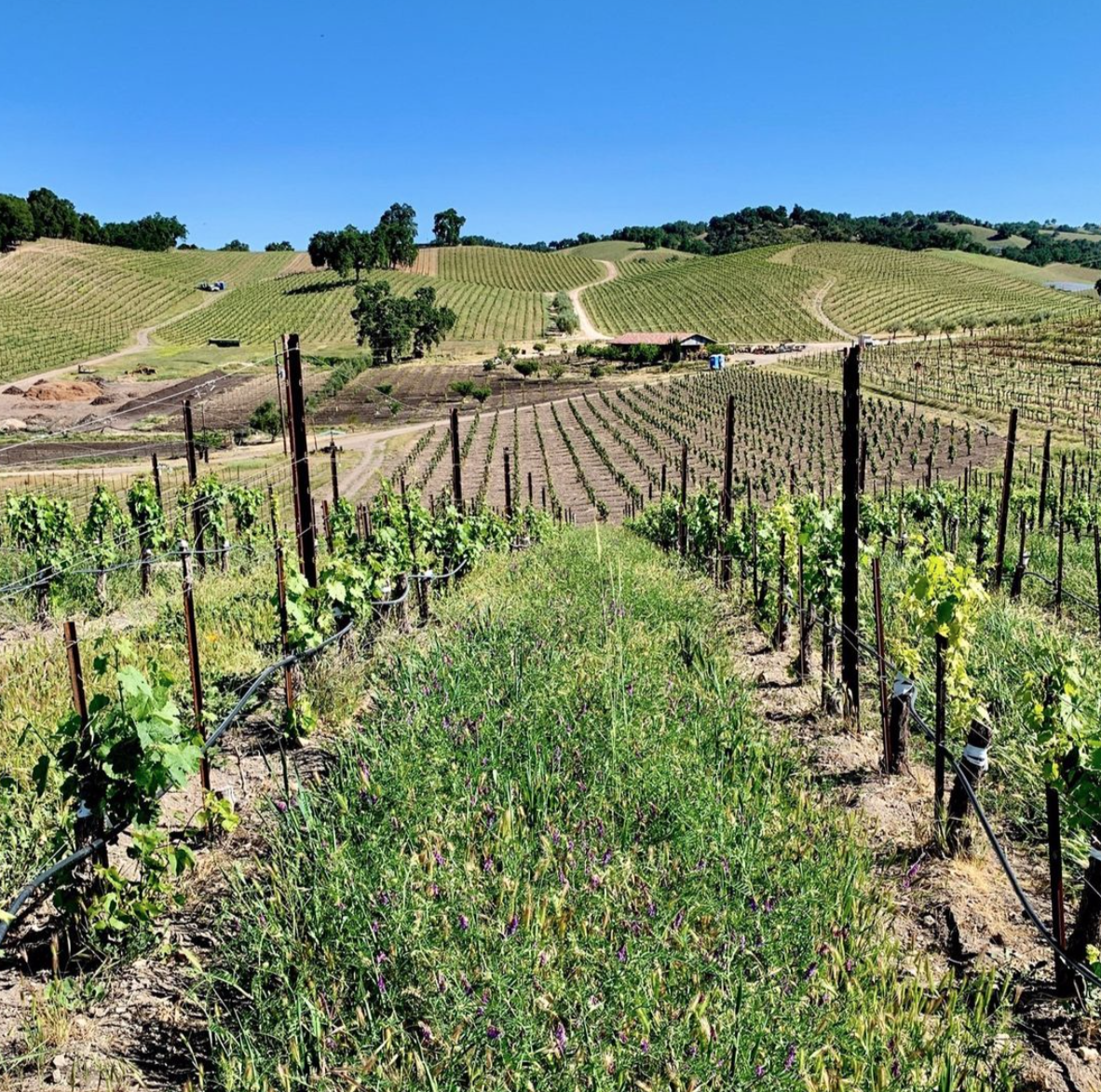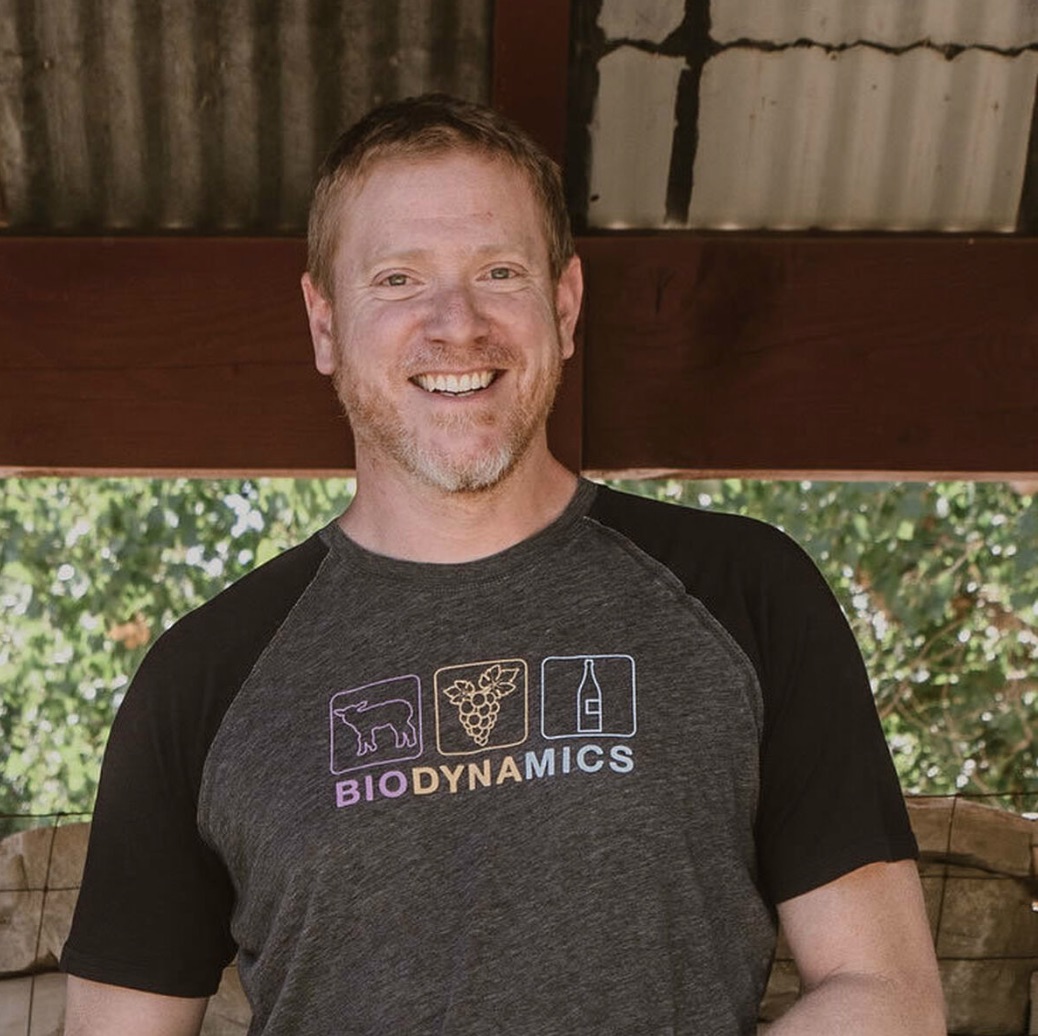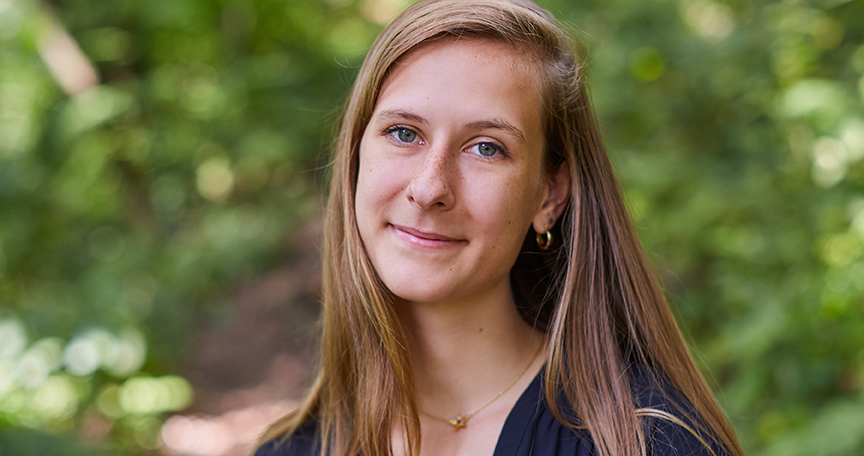
Tablas Creek, a winery founded in 1989 as a partnership between California’s Haas family and the Perrin family of Château de Beaucastel in Châteauneuf-du-Pape, is a pioneer of California’s Rhône movement. These two families set out with the goal of establishing the grape varieties of the Southern Rhône in California. After searching up and down the state for a site that offered terroir similar to that of the Southern Rhône, they found the perfect climate and limestone-rich soils in the Adelaida district of Paso Robles. Tablas Creek has painstakingly imported vine cuttings directly from the Beaucastel estate, each going through a rigorous USDA-mandated three-year quarantine and has now successfully imported and grown every grape variety permitted in Châteauneuf-du-Pape.
Tablas Creek features these grapes in Rhône-style blends as well as rare single varietal bottlings. In addition to leading the charge of planting Rhône varieties in California, Tablas Creek is also a forerunner in organics, biodynamics, and regenerative agriculture in America. Tablas Creek has been certified organic since 2003 and is the first ever regenerative organic certified vineyard in the United States. I sat down with Jason Haas to discuss Tablas Creek’s unique partnership with the Perrin family, their commitment to sustainable practices, and the challenges and rewards associated with introducing US consumers to a new style of wine.
Hannah Staab: Could you to explain the relationship with the Perrin family and how Tablas Creek has evolved over time as a winery? How did that start out and how has it progressed over time?
 Jason Haas: Tablas Creek has always been, since its conception, imagined as a partnership where we're trying to translate the ideas of Châteauneuf-du-Pape into California. So, the idea for what we wanted to do came before the place that we're doing it. That relationship came about because my dad was a wine importer for his main adult career and he became friendly with the Perrin family who've owned and run Château de Beaucastel for the last five generations, and he would make trips around the United States with Jean-Pierre and Francois Perrin, two brothers who ran the estate starting in the 1970s. He would visit California because it's a huge wine market. Every time they visited California, they'd come back talking about how much it reminded them of Châteauneuf-du-Pape and how surprised they were that in this Mediterranean climate, nobody had focused on Rhône varieties.
Jason Haas: Tablas Creek has always been, since its conception, imagined as a partnership where we're trying to translate the ideas of Châteauneuf-du-Pape into California. So, the idea for what we wanted to do came before the place that we're doing it. That relationship came about because my dad was a wine importer for his main adult career and he became friendly with the Perrin family who've owned and run Château de Beaucastel for the last five generations, and he would make trips around the United States with Jean-Pierre and Francois Perrin, two brothers who ran the estate starting in the 1970s. He would visit California because it's a huge wine market. Every time they visited California, they'd come back talking about how much it reminded them of Châteauneuf-du-Pape and how surprised they were that in this Mediterranean climate, nobody had focused on Rhône varieties.
The structure of how Tablas Creek is set up was set up at the beginning with the two families as equal partners. That happened back in 1985 and they spent the next four years looking for the right spot, which meant calcareous soils, enough rainfall to dry farm, a long enough growing season, and an intermediate climate with some ocean influence, but not too much that allows you to do both the early ripening Rhône varieties like Syrah and the late ripening ones like Roussanne credibly. It's actually tricky to find spots where those all work, but because it's fairly cool here, because the nights are so cold, 95 degrees outside notwithstanding, the grapes ripen a little slower here.
It was always conceived of as this partnership, but we didn't know the spot. When we found the spot at Paso Robles, it was to our surprise as much as anybody else's. It's turned out to be, if anything, even better in terms of the grape growing characteristics than we had thought it was at the beginning.
What has been the best strength and the biggest challenge associated with such a unique partnership?
I think in terms of the partnership, there haven't been a lot of challenges. We have a great relationship as families, and that underpinned the whole thing. There've been a lot of challenges with the business. When we started, we were making blends, which didn't yet have a category, from grapes that people didn't know and couldn't pronounce, in a part of California that they'd never heard of, with French names that didn't mean anything to them.
We had four strikes against us from the beginning and the first three, four, five years were a real struggle in the market just to get ourselves established. It wasn't really until we opened our tasting room here in 2002, and took a more direct role in our own marketing that we started to kind of build the audience and the customer base that we needed to in order for the business part of it to be successful. So the partnership has been great, it's incredible having the experience of five generations of Perrins there to lean on when we need to, but that doesn't mean that the business side of things has been easy.
Speaking of the varieties that people might not be so aware of in the US, what are some of the more rare varieties that you are planting right now, and which ones are you most excited about?
At the beginning, we decided to focus on the main varieties that the Perrins use, at Beaucastel. So our first round of imports was, Mourvedre, Grenache, Syrah, Counoise, Roussanne, Marsanne, Viognier, and Grenache Blanc. We've decided that it's just a worthy endeavor to try to bring in all of the Châteauneuf grapes. We've gotten them all through quarantine now.
Some of the ones that I think have been better than we ever thought they would include the high-acid white varieties. I think these are starting to come back into fashion in France, things like Clairette Blanche, Picpoul and Picardan, but they're so valuable here in California. You can use them to brighten grapes, like Roussanne and Viognier that are pretty rich and lush, but a little lower in acid. You can also leave them on the vine long enough that they have intensity and character and persistence that they don't generally get it France, so those have been really exciting.
In terms of the really new stuff, we've just bottled the first ever Vaccarese in America, first one we think outside of France ever. It's a wildly interesting grape. It's sort of herby and dark fruited and spicy and relatively high in acid, medium tannin. It reminds me almost of like a Loire red, more than it does something from the Rhône. There are just no parallels to this. There's no examples of this in France, because it's so rare even there. Getting a chance to figure out what these obscure grapes are all about and try to go back and figure out why would these have become unpopular? "Oh, it's because they're susceptible to powdery mildew," which is not really an issue for us, so great. Let's go with it.
Those are some of the ones I think that have really been fun to work with that are newer. And then of course, the kind of the core of what we started doing at the beginning included grapes like Grenache Blanc, Mourvedre, and Counoise that I think either we're not planted here or not taken seriously here and have turned out to be really great.
You're also the first organic regenerative certified vineyard in the U.S. and I was wondering, what does this certification mean?
It starts with the organic certification; you have to have eliminated the use of chemical herbicides and pesticides and fertilizers. Beyond that, it requires that you focus on a couple of things. First of all, soil health in a measurable way, you have to show that you are using your crop and your cover crops to be pulling carbon out of the atmosphere and fixing it into the soil. You have to do soil tests to show your soil carbon. There are a bunch of advantages to that beyond just the climate change pieces, a higher carbon content in your soil retains more moisture and generally has a better soil structure, so that vines roots can access the nutrients better.
Then, it requires that you reduce your use of non-renewable resources, reduce your use of water and reduce your use of energy. We've got four banks of solar panels, the last one just got hooked up earlier this year and should get us to a 100% solar. We've been planting an increasing percentage of our vineyard wide spaced, dry farmed, and unirrigated, and those turned out to be really successful.
Then there are separate pillars for animal welfare and for farm worker fairness, so those are looking at your business practices more than they're looking at your farming specifically. The animal welfare piece requires that the animals be treated humanely and have room to express normal behavior and are provided shelter. Essentially, there's the five freedoms of animal welfare that you basically have to follow that. And then the far more preparedness piece is you have to show that not only are your farm workers being paid a living wage, not only are their working conditions safe, but you've set up structures where their feedback is encouraged and solicited and acted upon.
Taken altogether, the idea behind regenerative organic is that it is a way for farming to be a part of the solution to some of the big picture questions that we are dealing with now, and will only become more acute as a state, country, and world. It's not a wine specific certification, we were invited to be the pilot participants for wine, but there are other regenerative organic protocols for cotton, row crops, orchards, aquaculture, chocolate, and all these different things. The idea is that it can be rolled out across lots of different types of farming and cumulatively can make a big impact on the resources that farming requires and the contribution that it can make to things like reducing atmospheric carbon.
As I'm someone who advocates for organic and regenerative practices a lot, what has motivated you to pursue these extra certifications and try to push for organic agriculture?
It starts with something that we inherit from Beaucastel, which is just the belief that farming organically is the best way that you have to make wines that express the character of the place in which they're grown. That's our baseline, that was why we've been farming organically since the beginning. We realized that if that's the motivation, then really we should be looking to eliminate outside inputs. It's great not to put on chemical fertilizers, but it'd be even better not to have to put on organic fertilizer and instead produce the soil fertility that you need through ways that can happen right here. Whether that's cover cropping, whether that's running a herd of 200 sheep through the vineyard that fertilize with their manure, or whether that’s interplanting with other things that are going to attract beneficial insects and microorganisms, and making sure that you have really healthy soil. All of that feels to us like a continuation of the same reason for farming organically.
Beyond that, it just feels like an opportunity. It feels like a chance to be a part of the solution to big problems. Wine in a lot of ways is, I think, in a really good position to lead this push because you have a value added product that is already associated with a place. You have a brand, which is associated with a place and estate on a state vineyard around a winery, and so we can tell the story to our customers in a way that's a lot harder for a cotton farmer or somebody who's farming cocoa beans, because they're not connected to their end customer in the way that we are. I feel like wine has the advantage of that connection with place and that direct connection with customer, but it's also a relatively easy product to farm in a way that has low inputs, because grapevines evolved in a part of the world. It's dry, rocky and generally challenging in high stress anyway. They're adapted to a relatively difficult life, and in fact, they make the best grapes and the best wine when they're forced to struggle.
Do you see climate change posing a challenge for Paso Robles as a wine region in the near future? What do you think that will look like in this region?
I think it already is. Though, not for the reason that most people think, it's not because it's getting hotter. Yes, it was hot, but it was always hot and the nights are cold enough. That's not by itself. The bigger issue, I think, is the availability of water that in general, most of the projections that I've seen show that as the climate warms in California, the storm track generally moves north and you get less rain in the winter. Then when you do get rain, it tends to come in these big, massive storms that are less prone to sinking in and more prone to running off. So, I think the biggest issue for Paso is going to be water availability, particularly groundwater. That's one of the reasons why we have made such a big push into dry farming is that it's ultimately going to be a lot more sustainable to space your vines further apart and let them subsist on what they get from the sky. Even if it's 20% less on average than it is now, in 50 years, then it is to rely on groundwater supplies that everybody is going to be competing for and with more planting, there's going to be more pressure on them anyway.
How do you view the role of winemaker as a communicator, as one who is active on social media and has a podcast?
I'm not sure that it necessarily does or has to, but I realized pretty early on because of all of those challenges that we had and explaining what we were doing to potential customers, that if we didn't figure out some way to get people inside our world, it was going to be a really hard problem to solve. It always felt like it was worthwhile investing the time in telling the story in a way that made sense to people. At the beginning that was inviting people out here and speaking at seminars and symposia wine events, working with writers. As technology got better, it was starting a blog so that people didn't physically have to be where we were to tell the story. Then with social media, it's just gotten easier. And particularly during the pandemic, it's become essential because people cannot physically go to where you are or could not for more than a year.
I feel like having the ability to tell our story across different platforms and to get people engaged in the same things that we're excited about and at the same things that we're afraid of and the same things that we're looking forward to is one of the most powerful ways of marketing something. Particularly something that's new to people and for all of the growth and sophistication of the American wine market. What we're doing is still a pretty niche thing, Rhône varieties and blends. Even if you lump Syrah in with that, it's still less than 5% of the U.S. wine market. I feel like we've got to take an active role in telling that story. I happen to like to write, that's certainly been a piece of it. I think we've got enough interesting story pieces that people have wanted to come and talk to me about it, which I think is great. I'm thrilled by that, but it all came out of that initial belief that if we didn't tell our story, nobody else was going to.











